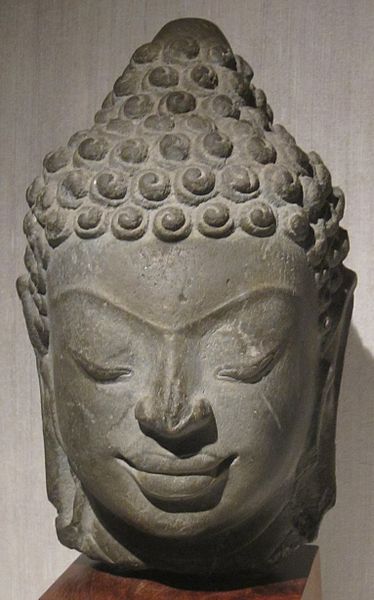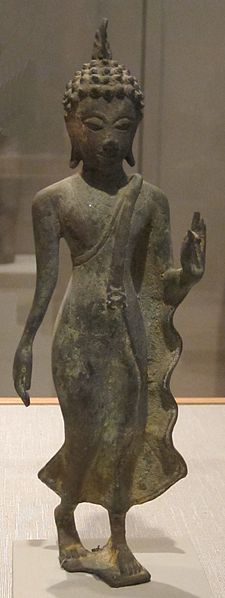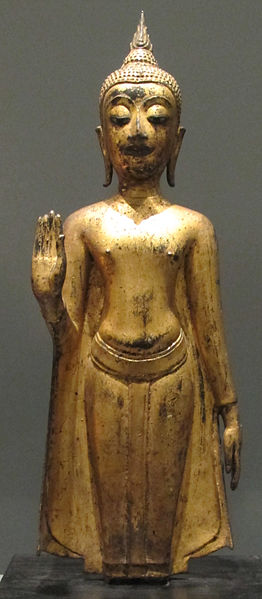22.10: Thai Art
- Page ID
- 53083
Thai Buddhist Sculpture
The history of Thai Buddhist sculpture can be divided into three broad phases: the Dwaravati period, the Sukhothai period, and the Ayutthaya period.
Learning Objectives
Identify the primary features of the Dwaravati, Sukhothai, and Ayutthaya periods in Thailand
Key Takeaways
Key Points
- Traditional Thai art primarily consists of Buddhist art with influences from Thai folklore and Hinduism; Thai sculptures most often depict images of the Buddha and other characters from Buddhist and Hindu mythology.
- From the 1st to the 7th centuries, art in Thailand was influenced by direct contact with Indian traders and the expansion of the Mon Kingdom, leading to the creation of Hindu and Buddhist art inspired by Indian traditions.
- The history of Buddhist sculpture in Thailand until the 18th century can be divided into three broad phases: the Dwaravati period (6th–11th centuries), the Sukhothai (13th–15th centuries) period, and the Ayutthaya period (14th–18th centuries).
- The Indian styles of the Amaravati and Gupta empires formed the basis of much of Dwaravati art, which produced both Hindu and Buddhist images, usually taking the form of monumental statues. The Sukhothai period witnessed the development of four classic postures of the Thai Buddha: walking, standing, sitting, and reclining. Later Thai art was highly influenced by Sukhothai images and continued to imitate these postures.
- Artists of the late Ayutthaya period usually depicted the Buddha in royal attire, set on ornate bases. Sculptures were often gilded, or decorated with gold leaf in free-form designs on lacquer backgrounds.
Key Terms
- aureole: Any luminous or colored ring that encircles something; often a circle of light or halo surrounding a deity.
- yaksha: A spirit that watches over the treasures hidden in the earth and tree roots.
- Mon: A people living primarily in Myanmar (also known as Burma) and Thailand; one of the earliest peoples to reside in Southeast Asia and who were responsible for the spread of Buddhism in Burma and Thailand.
Background: Traditional Thai Art
Traditional Thai art primarily consists of Buddhist art and, to a lesser extent, Hindu-influenced Thai folklore. From the 1st to the 7th centuries, art in Thailand was influenced by direct contact with Indian traders and the expansion of the Mon Kingdom, leading to the creation of Hindu and Buddhist art inspired by the Gupta tradition of India. Thai sculptures most often depict images of the Buddha and other characters from Buddhist and Hindu mythology, while Thai paintings comprise book illustrations and painted ornamentation of temples and palaces. The history of Buddhist sculpture in Thailand until the 18th century can be divided into three broad phases: the Dwaravati period, the Sukhothai period, and the Ayutthaya period.
Buddhist Sculpture in Thailand
Dwaravati Period (6th–11th centuries)
The Indian styles of the Amaravati and Gupta empires formed the basis of much of Dwaravati art, which produced both Hindu and Buddhist images, usually taking the form of monumental statues. From the 9th century onward, Mahayana influences such as the Cambodian Khmer style in the north and the Sri Vijaya style in the south became more important. Dwaravati art came to represent the Mahayana pantheon , portraying multiple creations of Bodhisattvas , or enlightened beings.
Three important styles of portraying the Buddha emerged during the Dwaravati period:
- Buddha in the Tribhanga (leaning) position, with Indian features and no aureole .
- Buddha in the Amaravati style with loosely folded legs, a continuous eyebrow, flat nose, thick lips, and a lotus-shaped aureole.
- A square-faced Buddha with a cleft chin, Khmer features, and fully folded legs, sitting on a lotus base.

Head of Buddha, Dvaravati Kingdom, 8th–9th Century: The continuous eyebrow and thick lips of this sculpture are characteristic of the Amaravati style patronized by Dwaravati.
Sukhothai Period (13th–15th centuries)
Theravada Buddhism from Sri Lanka arrived in Thailand for the first time the 13th century, at the same time that the Sukhothai kingdom was established in north-central Thailand. Theravada Buddhism had a considerable influence on Sukhothai art, which favored highly stylized images of the Buddha—images cast with the intention of depicting his superhuman traits and in keeping with his canonical defining marks, as set out in ancient Buddhist texts. Sukhothai Buddhas usually had finely curled hair, a slight smile, broad shoulders, and a slender oval face and were accompanied by a flame-shaped aureole. Small anatomical details were frequently omitted to emphasize the Buddha’s spiritual aspects.
The Sukhothai period witnessed the development of four classic postures of the Thai Buddha: walking, standing, sitting, and reclining. Later Thai art was highly influenced by Sukhothai images and continued to imitate these postures.

Bronze Walking Buddha, Thailand, Sukhothai Kingdom, 15th Century: The Sukhothai period witnessed the development of Buddha images in a walking position.
Ayutthaya Period (14th–18th centuries)
Ayutthaya sculptures were executed in stone, bronze , and brick and stucco . The period was characterized by juxtaposed rows of Buddha figures. The influence of the Sukhothai period continued to loom large, particularly in bronze Buddha images, which were portrayed in Sukhothai poses. Artists of the late Ayutthaya period usually depicted the Buddha in royal attire, set on ornate bases. Sculptures were often gilded, or decorated with gold leaf in free-form designs on lacquer backgrounds.

Standing Buddha, Thailand, Ayutthaya kingdom, 16th Century: Gilded sculptures of the Buddha became popular during the Ayutthaya period.
Thai Painting
Thai painting traditionally took the form of book illustrations and ornamentation of temples and palaces.
Learning Objectives
Detail the components that are common to Thai painting
Key Takeaways
Key Points
- While Thai sculptures most often depict images of the Buddha and other characters from Buddhist and Hindu mythology, Thai paintings traditionally comprised book illustrations and painted ornamentation of temples and palaces.
- Paintings of Thai Buddha from different periods have a number of distinctive styles , and contemporary Thai art often combines traditional Thai elements with modern techniques.
- Traditional Thai paintings show subjects in two dimensions without perspective , and the size of each element in the picture reflects its degree of importance.
- The most frequent themes for Thai painting are illustrations of the Jataka tales , events from the life of the Buddha, the Buddhist heavens and hells, and scenes from daily life.
- Paintings from the mid-19th century onward began to show the influence of Western art, for example, with the introduction of perspective.
Key Terms
- Jataka tales: A voluminous body of literature native to India concerning the previous births and lives of Gautama Buddha, in both human and animal form.
- perspective: In the graphic arts, an approximate representation on a flat surface (such as paper) of an image as it is seen by the eye: objects are smaller as their distance from the observer increases.
Overview
Traditional Thai art primarily consists of Buddhist art and, to a lesser extent, Hindu-influenced Thai folklore. While Thai sculptures most often depict images of the Buddha and other characters from Buddhist and Hindu mythology, Thai paintings traditionally comprised book illustrations and painted ornamentation of temples and palaces. Paintings of Thai Buddha from different periods have a number of distinctive styles, and contemporary Thai art often combines traditional Thai elements with modern techniques.
Themes of Thai Painting
Traditional Thai paintings show subjects in two dimensions without perspective. An important element in the composition is the apportioning of areas: the main elements in the image are isolated from one another by space transformers, which eliminate the intermediate ground that would otherwise imply perspective. The size of each element in the picture reflects its degree of importance. Perspective was introduced only as a result of Western influence in the mid-19th century.

Thai Painting of the 19th Century: A depiction of a white elephant in 19th century Thai art.
The most frequent themes for Thai painting are illustrations of the Jataka tales (a vast body of fables about the previous incarnations of the Buddha, both in human and animal form ), events from the life of the Buddha, the Buddhist heavens and hells, and scenes from daily life. The paintings reflect a blend of Thai folklore and traditional Buddhist iconography .
Historical Progression
The Sukhothai period began in the 13th century in the Sukhothai kingdom and dominated through the 15th century. Painted images often consisted of decorations of gold leaf in free-form designs on a lacquer background. Images of Buddha during this period are elegant, with sinuous bodies and slender, oval faces. This style emphasized the spiritual aspect of the Buddha and tried to follow the canonical defining marks of a Buddha, as they are set out in ancient Pali texts:
Painting following the Sukhothai period was more elaborate, with Buddha images often depicted in royal attire. Paintings from the mid-19th century onward began to show the influence of Western art, such as the use of perspective.

Ramakien in Wat Phra Kaew: Hanuman on his chariot, a scene from the Ramakien in Wat Phra Kaew, Bangkok.
Thai Buddhist Architecture
The most common form of Buddhist architecture seen in Thailand is the wat, or monastery temple, which is characterized by multiple-tiered roofs.
Learning Objectives
Discuss the influence of Buddhism on Thai architecture
Key Takeaways
Key Points
- With few exceptions, a Thai temple usually consists of two parts: the phuttawat, the area dedicated to the Buddha, and the sanghawat, the living quarters of the Buddhist monks.
- Temples typically have two or three tiers, although royal temples may have four. The use of multiple roof tiers is more aesthetic than functional, as it has the effect of lightening the roof’s massive appearance.
- Roofs of Thai temples are further decorated with finials known as lamyong, sculpted in a serpentine shape and resembling the feathers of Garuda, a mythical bird-like creature from Hindu and Buddhist mythology.
Key Terms
- wat: A buddhist temple in Thailand, Cambodia, or Laos.
- finial: Any decorative fitting at the peak of a gable, or on the top of a flagpole, fence post, or staircase newel post.
Buddhist Monastery Temples
The most common form of Buddhist architecture seen in Thailand is the wat, or monastery temple. Although wat architecture has seen many changes in Thailand in the course of history, and there are many differences in layout and style , most monasteries adhere to the same principles. With few exceptions, a Thai temple usually consists of two parts: the phuttawat, the area dedicated to the Buddha, and the sanghawat, the living quarters of the Buddhist monks.
Roof Forms
Multiple roof tiers are an important element of the Thai temple—a technique reserved only for the roofs of temples, palaces, and important public buildings. Temples typically have two or three tiers, although royal temples may have four. The use of multiple roof tiers is more aesthetic than functional. Because temple halls are large, their roof areas are also quite large, and multiple tiers have the effect of lightening the roof’s massive appearance. The lowest tier is the largest, with a smaller middle layer and the smallest tier on top. Individual layers themselves have multiple breaks as well—a double-tiered roof might have two to four breaks in each tier, for example—that further lighten the effect and create dynamic visual rhythms.
In northern temples, the roof area tends to be larger, sweeping low toward the ground to cover more of the wall. The lower tiers telescope farther to the entrance. In central Thai temples, the lower tiers telescope just a short distance beyond the top roof at the gable ends.

Phra Maha Chedi Si Ratchakan at Wat Pho, Bangkok.: Thai Buddhist monasteries, or wats, are known for their elaborate tiered roofs.
Roof Finials
Roofs of Thai temples are typically decorated with finials attached to the bargeboard, the long, thin panel on the edge of the roof at the gable ends. The most common finial is called the lamyong, sculpted in a serpentine shape and resembling the feathers of Garuda, a mythical bird-like creature from Hindu and Buddhist mythology. The lamyong is surmounted by a large, curving ornament called the chofah, which represents the beak of Garuda. Temples may also be decorated with sculptures and paintings of other mythical beings from Hindu and Buddhist iconography , including the many-armed gods Vishnu and Shiva, the elephant god Ganesh, the naga or serpent deity , and the ghost-banishing giant Yaksha . A roof with multiple breaks or tiers will have identical finials at the bottom of each section.

Wat Phra Singh in Chiang Mai: The roofs of wats were commonly decorated with finials of mythical creatures.
- Curation and Revision. Provided by: Boundless.com. License: CC BY-SA: Attribution-ShareAlike
- Thai head of Buddha, Dvaravati kingdom, 8th-9th century, Dayton. Provided by: Wikimedia. Located at: commons.wikimedia.org/wiki/File:Thai_head_of_Buddha,_Dvaravati_kingdom,_8th-9th_century,_Dayton.jpg. License: Public Domain: No Known Copyright
- Provided by: Wikimedia. Located at: upload.wikimedia.org/Wikipedia/commons/thumb/d/d1/Tailandia,_ayutthaya,_buddha_stante,_1500-1600_ca..JPG/262px-Tailandia,_ayutthaya,_buddha_stante,_1500-1600_ca..JPG. License: CC BY-SA: Attribution-ShareAlike
- Bronze walking Buddha, Thailand, Sukhothai kingdom, 15th century, Honolulu Academy of Arts. Provided by: Wikimedia. Located at: commons.wikimedia.org/wiki/File:Bronze_walking_Buddha,_Thailand,_Sukhothai_kingdom,_15th_century,_Honolulu_Academy_of_Arts.jpg. License: Public Domain: No Known Copyright
- Thai temple art and architecture. Provided by: Wikipedia. Located at: en.Wikipedia.org/wiki/Thai_temple_art_and_architecture. License: CC BY-SA: Attribution-ShareAlike
- Buddha images in Thailand. Provided by: Wikipedia. Located at: en.Wikipedia.org/wiki/Buddha_images_in_Thailand. License: CC BY-SA: Attribution-ShareAlike
- History of Eastern art. Provided by: Wikipedia. Located at: en.Wikipedia.org/wiki/History_of_Eastern_art%23Thai_art. License: CC BY-SA: Attribution-ShareAlike
- Thai art. Provided by: Wikipedia. Located at: en.Wikipedia.org/wiki/Thai_art. License: CC BY-SA: Attribution-ShareAlike
- Mon. Provided by: Wikipedia. Located at: en.Wikipedia.org/wiki/Mon. License: CC BY-SA: Attribution-ShareAlike
- aureole. Provided by: Wiktionary. Located at: en.wiktionary.org/wiki/aureole. License: CC BY-SA: Attribution-ShareAlike
- finial. Provided by: Wiktionary. Located at: en.wiktionary.org/wiki/finial. License: CC BY-SA: Attribution-ShareAlike
- yaksha. Provided by: Wiktionary. Located at: en.wiktionary.org/wiki/yaksha. License: CC BY-SA: Attribution-ShareAlike
- RoyalWhiteElephant.jpg. Provided by: Wikipedia. Located at: en.Wikipedia.org/wiki/Thai_art#/media/File:RoyalWhiteElephant.jpg. License: Public Domain: No Known Copyright
- 1280px-WatPhraKeaw_Ramayana_Chariot.JPG. Provided by: Wikipedia. Located at: en.Wikipedia.org/wiki/Thai_art#/media/File:WatPhraKeaw_Ramayana_Chariot.JPG. License: Public Domain: No Known Copyright
- Thai temple art and architecture. Provided by: Wikipedia. Located at: en.Wikipedia.org/wiki/Thai_temple_art_and_architecture. License: CC BY-SA: Attribution-ShareAlike
- Thai Art. Provided by: Wikipedia. Located at: en.Wikipedia.org/wiki/Thai_art. License: CC BY-SA: Attribution-ShareAlike
- History of Asian Art. Provided by: Wikipedia. Located at: en.Wikipedia.org/wiki/History_of_Asian_art. License: CC BY-SA: Attribution-ShareAlike
- 1024px-Thai-roof.jpg. Provided by: Wikipedia. Located at: en.Wikipedia.org/wiki/Thai_temple_art_and_architecture#/media/File:Thai-roof.jpg. License: CC BY-SA: Attribution-ShareAlike
- 800px-BOB_3205-3.jpg. Provided by: Wikipedia. Located at: en.Wikipedia.org/wiki/Thai_art#/media/File:BOB_3205-3.jpg. License: CC BY-SA: Attribution-ShareAlike
- Thai Art. Provided by: Wikipedia. Located at: en.Wikipedia.org/wiki/Thai_art. License: CC BY-SA: Attribution-ShareAlike
- Thai temple art and architecture. Provided by: Wikipedia. Located at: en.Wikipedia.org/wiki/Thai_temple_art_and_architecture. License: CC BY-SA: Attribution-ShareAlike

